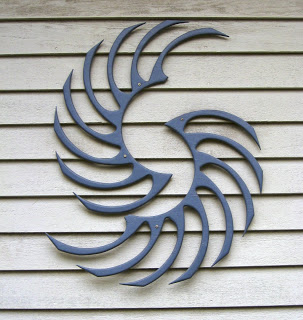Saturday
Nov082008
Part 1 - Where do sculpture ideas come from?
 Saturday, November 8, 2008 at 8:43PM
Saturday, November 8, 2008 at 8:43PM I'm often asked where I get my ideas. In the following series of blog posts I'm going to detail a recent experience of recursive inspiration.
Many years ago I threw some damaged sculpture parts into the wood recycle bin at the Ashford transfer station. Several weeks later we were all amused to find these parts displayed in an artful arrangement on the side of a local barn. Recycled art art!
Two years ago we repainted the outside of the studio. I had some extra Pegasus parts and decided to follow my neighbor's example by painting and attaching them to the front of the building. End of story I thought.
Jump forward to the summer of 2008. I walked by the painted parts as I had hundreds of times before but this time it occurred to me that this arrangement might make an interesting patterning wheel to use with my "Focus" type mechanism.
I've learned to save good ideas in a way that I'll be reminded of them later. I took a photo of the wall with my trusty iPhone, mailed it to myself, and left it in my mail inbox. This way I keep bumping into the photo when I clean out my inbox. I don't do this all that often so the "bumps" come at random times. I recently discovered the email and photo when I was updating my email notification list for the Falling Water sculpture. That "discovery" started a design sequence that I'm going to detail in the next few posts. They will chronicle the evolution of an idea. Stay tuned!

To continue to part 2: Click Here
Reader Comments (5)
Hi, I am fascinated by your work, it is beautiful. Tell me are the made entirely of wood,(outside of the spring), do you use bearing on the pivots?
Posted @ Monday, January 25, 2010 12:42 PM by dyogee2222
I use instrument grade ball bearings at all critical rotation points in my sculptures.
Earlier in my career I tried various types of wood and sleeve bearings but they were not efficient enough to achieve good run times.
Posted @ Monday, January 25, 2010 12:43 PM by David C Roy
Hi David ,
I saw your kinectic sculptures . kinectic sculptures seems to be more interseting that static sculptures .They tend to induce life in metal in form of breath which mechanically be termed as movements. Nature by vision seems to be static but a sculptor, a poet, or any artist in any field to has the ability to look beyond the screen and communicate with the static world. I would love to see more of your works in future
Posted @ Tuesday, February 02, 2010 8:20 PM by Shreyas
Shreyas - Thank you for your comment. Make sure you check out the other posts in the "Where do sculpture ideas come from" series.
Posted @ Tuesday, February 02, 2010 8:20 PM by David C. Roy
Hi, i have seen some of you videos, they are amazing. I'm a mechanical engineer and what i'm curious about how they run for so long without any help? Is it because of the instrumental bearing that u said u use? And what's required to maintain those bearings?
Posted @ Sunday, November 21, 2010 8:50 AM by Azim